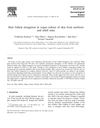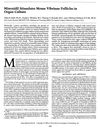The Study on Mechanism of Minoxidil's Promoting Effect on Cultured Adult Hair Follicles
January 2008
in “
Acta Anatomica Sinica
”
TLDR Minoxidil promotes hair growth by delaying the hair's resting phase.
The study investigated the mechanism by which minoxidil promotes hair growth in cultured adult hair follicles. It was found that minoxidil, particularly at a concentration of 1 mg/L, effectively increased hair follicle growth and delayed the onset of the catagen phase compared to the control. The study observed that minoxidil enhanced the expression of collagen I while reducing the expression of metalloproteinases-1 (MMP-1) and transforming growth factor β1 (TGFβ1). There was no significant difference in the expression of integrin β1 and K19 between the experimental and control groups. The findings suggested that minoxidil promotes hair follicle growth by inhibiting the overexpression of TGFβ1, thereby delaying catagen.




